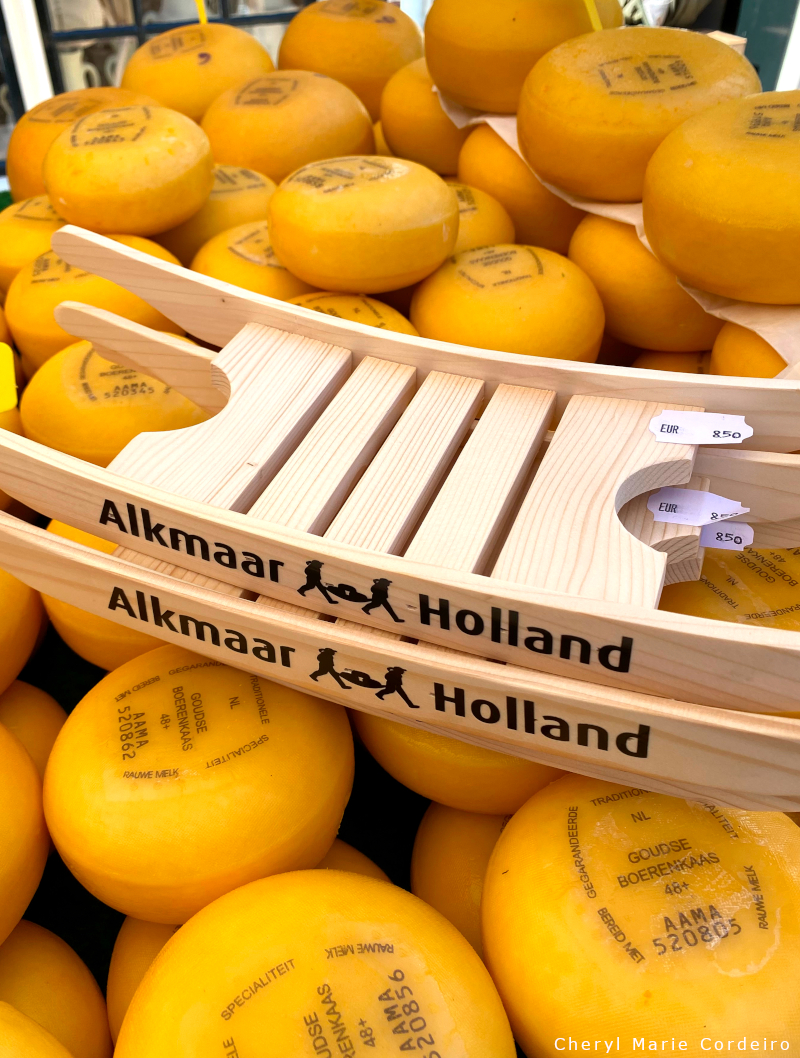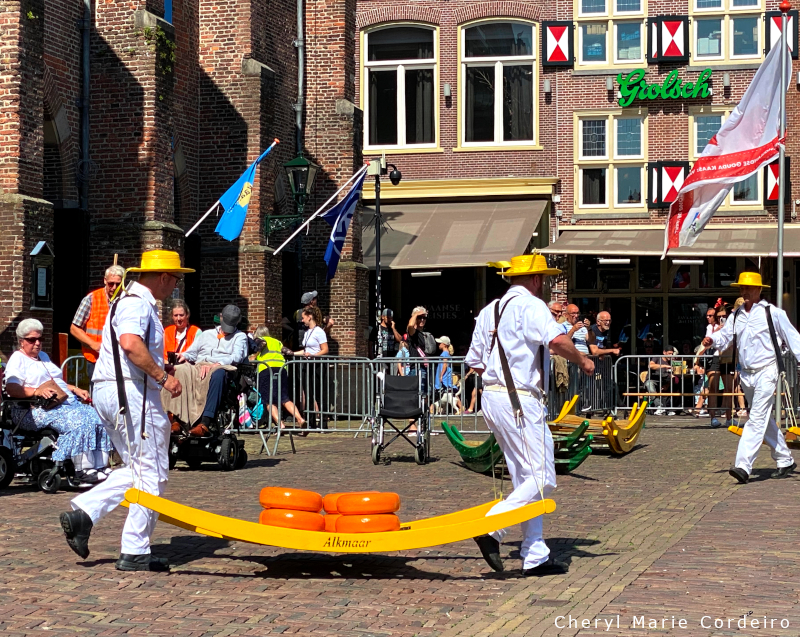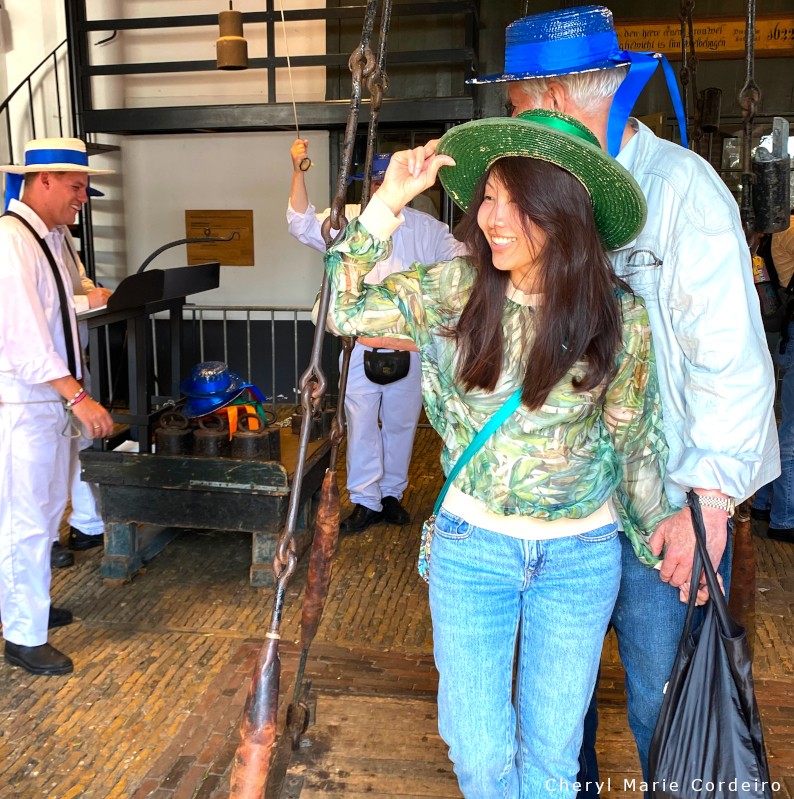At the Alkmaar Weigh House. The Waag building is a National monument / Rijksmonument listed building on the Waagplein in Alkmaar in the Netherlands. The Cheese Museum, Alkmaar, is also lcoated in this building.
Text & Photo © CM Cordeiro & , JE Nilsson 2023
Introduction
The Netherlands, known for its windmills, tulips, and canals, also boasts a vibrant cheese culture that dates back centuries. This blog post is a personal journey through the history, taste, and culture of Dutch cheese, with a special focus on the city of Alkmaar, the heart of the Dutch cheese industry located in Northern Holland.
A Tradition Rooted in History
The story of Dutch cheese is a tale that dates back to the Middle Ages. It’s a narrative deeply rooted in the country’s history and traditions, and it’s impossible to tell without mentioning the Dutch East India Company, Verenigde Oostindische Compagnie or VOC for short. Established in the early 17th century, the Dutch East India Company was a major player in the global spice trade. Its ships sailed to the farthest corners of the world, bringing back a variety of spices that would eventually find their way into Dutch cheese. The integration of these exotic flavors into local produce is a testament to the Dutch’s innovative spirit and their openness to the world. It’s a reflection of their willingness to experiment and adapt, to take something familiar and make it new and exciting. This spirit of innovation is still evident in the Dutch cheese industry today, with cheese makers continually experimenting with new flavors and techniques.
The Alkmaar Cheese Market, held every Friday morning from March to September, is a beautiful example of this tradition. The market, located in the Waagplein square, is a bustling hub of activity, attracting visitors from around the world. Here, you can witness the traditional Dutch method of cheese trading that date back to the 16th century. Cheese carriers, dressed in white uniforms and straw hats, transport the cheese in barrows from the market to the weighing house, known as ‘de Waag’. The activities of the cheese market today, is a nod to the medieval times when Dutch cheese farmers would bring their produce to the market square to sell by land, or ferried up the river in small row boats.
A Feast for the Senses

To truly appreciate Dutch cheese, you’ll have to experience it with all your senses. The sight of a perfectly aged Gouda, the smell of a fresh Edam, the feel of a creamy Maasdam, the sound of a knife slicing through a wheel of firm or semi-firm cheese, and of course, the taste – each cheese has its unique flavor profile, from the mild and creamy to the sharp and tangy.
One Dutch cheese that stands out is Beemster. Made in the Beemster Polder, a UNESCO World Heritage site, Beemster cheese is renowned for its rich, buttery flavor and smooth texture. The secret lies in the Beemster Polder’s clay soil, which gives the grass a unique composition. The cows that graze on this grass produce milk that is rich, creamy and infused with the taste of the herbs and grass on which the cows have fed, resulting in a cheese that is truly unique.
My personal preference however leans towards goat and sheep cheese varieties. I love the distinct, slightly tangy flavor of goat and sheep cheese. One of my favorites is the semi-firm Dutch goat Gouda. It’s not your typical soft, fresh chèvre (which I also love). Instead, it’s a slightly firm, aged goat Gouda with a mild, sweet, and refreshing taste. The texture is smooth, and it pairs wonderfully with wildflower honey, crushed cashews, and whole wheat bread. It’s not unusual to pair crisp white wines or a pale lager beer to these cheese varieties.
More Than Just Cheese

Dutch cheese is more than just a culinary delight. It’s a reflection of the local people’s dedication to quality, tradition, and innovation. The cheese-making process, passed down through generations, is a testament to their respect for tradition. At the same time, their willingness to experiment with flavors and techniques shows their innovative spirit.
The result is a variety of cheeses in various colours, reflecting its infused ingredients that are as diverse and unique as the Dutch landscape itself, where all of about one third of the Netherlands lies below sea level. From the flat polders of Beemster to the rolling hills of Limburg, each region produces its unique cheese, each with its distinct flavor and texture.
Exploring Alkmaar
Once you’ve had your fill of the cheese market, Alkmaar has much more to offer. The city is home to more than 1,000 monumental buildings and is great for shopping. If you’re interested in learning more about cheese, visit the Dutch Cheese Museum located in the old weighing house, the Waag. For beer enthusiasts, the Beer Museum De Boom, a former brewery, offers insights into beer making and locally brewed samples.
Alkmaar’s history dates back to the 10th century, and it was granted city rights in 1254. The city’s oldest part lies on an ancient sand bank, offering some protection from inundation during medieval times. Today, Alkmaar is a bustling city that seamlessly blends the old with the new. Its historic city center, with its narrow streets, old buildings, and beautiful canals, is a testament to its rich history, while its modern infrastructure and amenities cater to the needs of its residents and visitors.
A Must-Visit for Cheese Lovers
The Alkmaar Cheese Market is a must-visit for any cheese lover. It’s not just about buying cheese; it’s about experiencing a piece of Dutch history and culture. So, if you find yourself in the Netherlands on a Friday between March and September, make sure to visit Alkmaar and immerse yourself in this unique cheese trading tradition.
Conclusion
The Dutch cheese experience is an exploration through history, taste, and culture. It’s an experiential narrative that takes you from the bustling cheese markets of Alkmaar to the quiet pastures of Beemster, from the rich, buttery flavor of Beemster cheese to the sharp tanginess of aged Gouda. It’s an experience that gives you a glimpse into the Dutch spirit of innovation, their respect for tradition, and their commitment to quality. So, whether you’re a cheese lover or a history buff, a visit to the Dutch cheese markets is a trip worth taking.
References
A Brief History of Dutch Cheese
History of the Alkmaar Cheese Market
Dutch Cheese Markets
The Dutch East India Company
Special Goat Cheese
Keywords: Dutch cheese, Dutch East India Company, Beemster cheese, Alkmaar, Dutch cheese markets, cheese trading, Dutch tradition, Dutch culture, Dutch history, Dutch culinary heritage, Dutch innovation, Dutch quality, Dutch landscape, North Holland, Waagplein, cheese lovers, cheese market day, goat cheese, sheep cheese.
